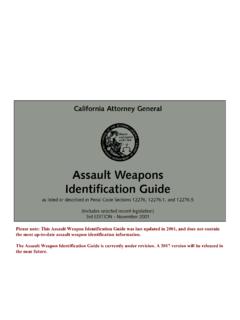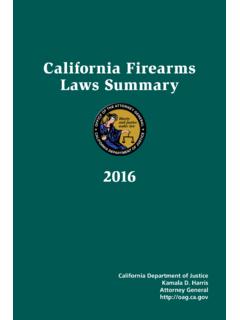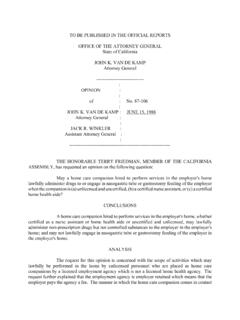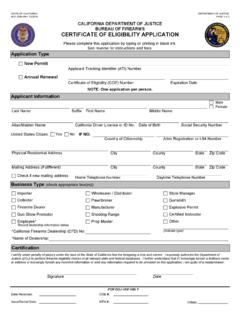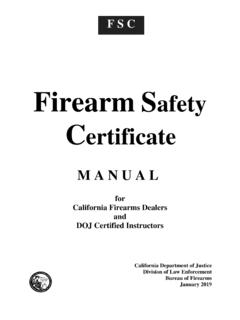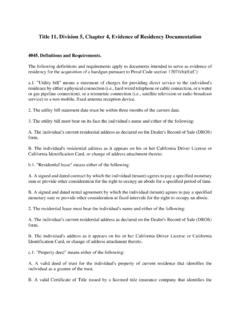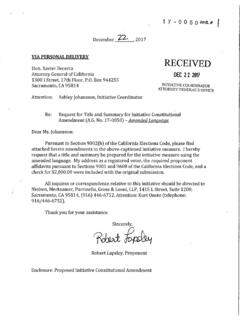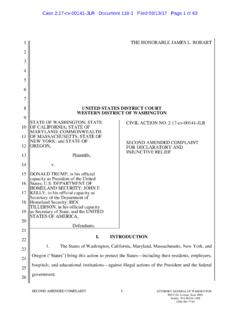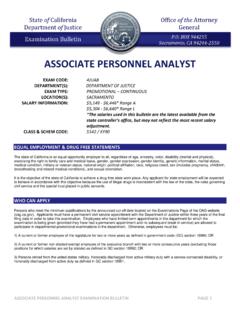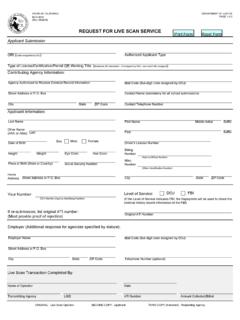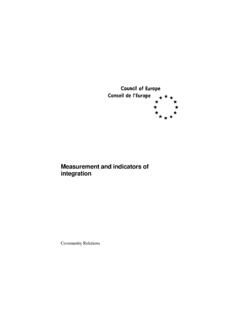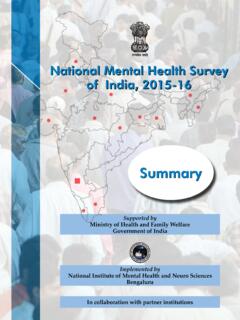Transcription of The California Transparency in Supply Chains Act
1 The California Transparency in Supply Chains ActA Resource Guide Kamala D. Harris, Attorney GeneralCalifornia Department of Justice2015 The California Transparency in Supply Chains ActA Resource Guide Kamala D. Harris, Attorney GeneralCalifornia Department of Justice2015 Table of ContentsExecutive Summary ..i Summary of Requirements and Overview of Model is the California Transparency in Supply Chains Act? ..3 Recommendations for Compliance and Model Disclosure Complying with the Format Placing a Direct Disclosure Link on a Business s Homepage..5 Making the Disclosure Link Making the Disclosure Link Easy to Complying with the Content Specific and Limited Content ..9 Requirement to Disclose the Extent of Efforts ..11 Verification ..11 Supplier Audits ..14 Internal Inadequate ..23 Acknowledgments ..24 Appendix A: Transparency in Supply Chains Act Statutory Language.
2 25 Appendix B: Beyond Required Disclosure: Other State and Federal Anti-Trafficking C: Anti-Slavery and Human Trafficking Resources ..31 Executive SummaryAn estimated 21 million people million women and girls and million men and boys are victims of forced labor around the These victims work in virtually every industry and across sectors, including manufacturing, agriculture, construction, entertainment and domestic service. California , which boasts the world s seventh-largest economy and the country s largest consumer base, is unique in its ability to address this issue, and as a result, to help eradicate human trafficking and slavery worldwide. In recent years, California consumers have demanded that producers provide greater Transparency about goods brought to market. Consumers utilize this additional information to drive their purchasing decisions, and various indicators suggest that Californians are not alone. A recent survey of western consumers revealed that people would be willing to pay extra for products they could identify as being made under good working A recent law in California is poised to help California consumers make better and more informed purchasing choices.
3 The California Transparency in Supply Chains Act (Steinberg, 2010) (the Act 3) provides consumers with critical information about the efforts that companies are undertaking to prevent and root out human trafficking and slavery in their product Supply Chains whether here or Act requires large retailers and manufacturers doing business in California to disclose on their websites their efforts to eradicate slavery and human trafficking from [their] direct Supply chain for tangible goods offered for sale. 4 The law applies to any company doing business in California that has annual worldwide gross receipts of more than $100 million and that identifies itself as a retail seller or manufacturer on its California tax return. Companies subject to the Act must post disclosures on their Internet websites related to five specific areas: verification, audits, certification, internal accountability, and training. The California Transparency in Supply Chains Act does not mandate that businesses implement new measures to ensure that their product Supply Chains are free from human trafficking and slavery.
4 Instead, the law only requires that covered businesses make the required disclosures even if they do little or nothing at all to safeguard their Supply Chains . Companies subject to the Act must therefore disclose particular information within each disclosure category, and the Act offers companies discretion in how to do so. This Resource Guide is intended to help covered companies by offering recommendations about model disclosures and best practices for developing such disclosures. In each disclosure category, the Guide discusses how a company can provide disclosures that comply with the law, as well as enhance consumers understanding of its anti-trafficking and anti-slavery efforts. iSummary of Requirements and Overview of Model Disclosures All disclosures must be posted on the company s website and accessible by a conspicuous and easily understood homepage If a company subject to the law has no website, it must provide written disclosures within 30 days of receiving a written consumer request for the information.
5 The Resource Guide addresses each of the Act s requirements and provides model disclosures based on actual company disclosures that fit with the language and spirit of the law. Of course, the model disclosures provided in this guide are merely examples. There is no formula for a model disclosure because one size does not necessarily fit all. The best disclosures are those that are specific to the company and explain the company s efforts in clear, concise language. Conspicuous Format Requirement Statute: [P]osted on the retail seller s or manufacturer s Internet Web site with a conspicuous and easily understood link to the required information placed on the business homepage. 6 Key Requirement: The disclosure link must be conspicuous, easily understood, and located on a retailer s and manufacturer s Disclosures: Insert a direct link to the disclosure information on the company s corporate website and the websites of all of the company s brands.
6 Place the link in a conspicuous location, such as at the top or bottom of the homepage, and consider the use of conspicuous textual attributes as appropriate. Use a descriptive title for the link, such as California Supply Chains Act, or another relevant title that plainly alerts consumers to the content of the linked page. Devote the entire linked page to the five required Five Topic AreasCompanies subject to the law must disclose information about five specific topics related to human trafficking and their product Supply Chains . Each topic has a number of model disclosure suggestions that provide depth and context to consumers, while also recognizing a company s legitimate interest in protecting confidential, proprietary, and trade secret information. These model disclosure suggestions should make clear that compliance with the Act requires more than oblique and vague statements; instead, a covered company should look to its Supply chain practices and make disclosures tailored to those practices.
7 IiVerification Statute: [A]t a minimum, disclose to what extent, if any, that the retail seller or [e]ngages in verification of product Supply Chains to evaluate and address risks of human trafficking and slavery. The disclosure shall specify if the verification was not conducted by a third party. 7 Key Requirements: Confirm whether the company engages in verification activities to identify, assess and manage the risks of human trafficking in its product Supply chain. If the company conducts verifications, additionally disclose whether the company uses a third-party verifier. Model Disclosures: To explain the extent to which the company engages in verification, we recommend that the company: Describe the general methodology the company uses to verify entities in the product Supply chain in assessing those risks, including general information about the frequency of verifications. Describe whether the company assesses and manages potential risks related to the presence of labor brokers or third-party recruiters in its Supply Statute: [A]t a minimum, disclose to what extent, if any, that the retail seller or [c]onducts audits of suppliers to evaluate supplier compliance with company standards for trafficking and slavery in Supply Chains .
8 The disclosure shall specify if the verification was not an independent, unannounced audit. 8 Key Requirements: Confirm whether the company audits suppliers in evaluating compliance with the company s standards for trafficking and slavery in its Supply Chains . State whether the audits are independent and unannounced. viiiiiModel Disclosures: To explain the extent to which the company engages in auditing, we recommend that the company: Generally describe the audit methodology. Generally describe how the company selects suppliers to audit. Provide statistics on the general timeline, frequency, and number of announced and unannounced audits. Certification Statute: [A]t a minimum, disclose to what extent, if any, that the retail seller or [r]equires direct suppliers to certify that materials incorporated into the product comply with the laws regarding slavery and human trafficking of the country or countries in which they are doing business.
9 9 Key Requirement: State whether the company requires its direct suppliers to make the certification. Model Disclosures: To explain the extent to which the company engages in this activity, we recommend that the company: Provide a general description of the certification requirement and the consequences for violating it. Disclose whether the company requires its direct suppliers to further certify they comply with the labor laws of the countries in which they do business. Discuss any additional actions the company takes to encourage direct suppliers to comply with all relevant Accountability Statute: [A]t a minimum, disclose to what extent, if any, that the retail seller or [m]aintains internal accountability standards and procedures for employees or contractors failing to meet company standards regarding slavery and trafficking. 10 Key Requirement: Disclose whether the company has internal procedures for determining whether employees or contractors are complying with company standards regarding slavery and human Disclosures: To explain the extent to which the company maintains those standards and procedures, we recommend that the company: Generally describe those standards and procedures, including who has responsibility for monitoring compliance.
10 Provide a link to the company s code of conduct related to supplier workplace standards. Provide general information on the types of preventative and corrective actions it takes. Disclose any mechanisms in place to help workers understand the company s fair labor requirements, including protections for workers who lodge grievances or report Statute: [A]t a minimum, disclose to what extent, if any, that the retail seller or [p]rovides company employees and management, who have direct responsibility for Supply chain management, training on human trafficking and slavery, particularly with respect to mitigating risks within the Supply Chains of products. 11 Key Requirement: Confirm whether the company engages in the specified training. vModel Disclosures: To illustrate the extent to which the company engages in relevant training, we recommend that the company: Identify levels of employees being trained by category or type.
